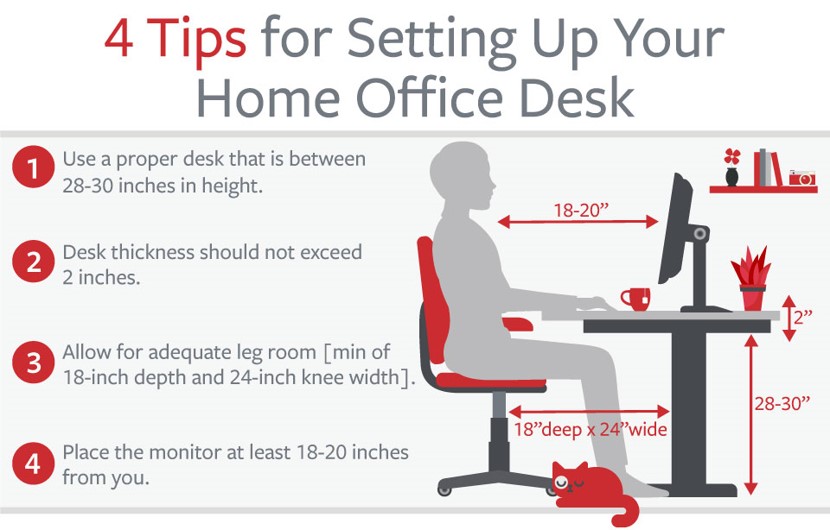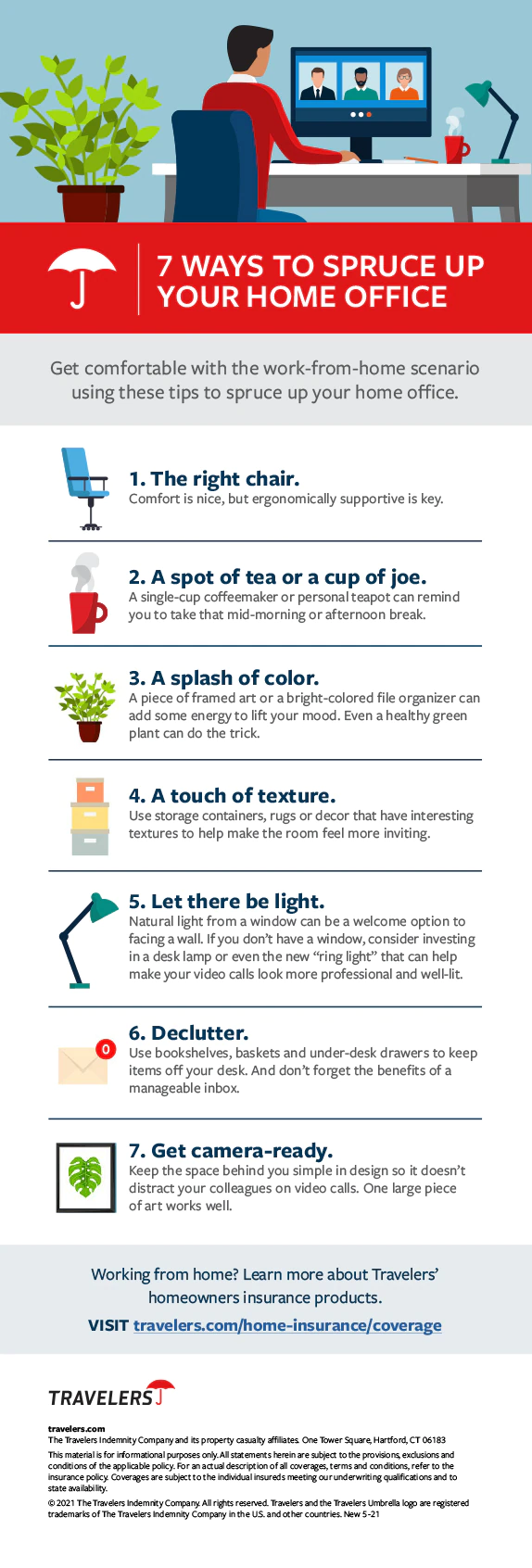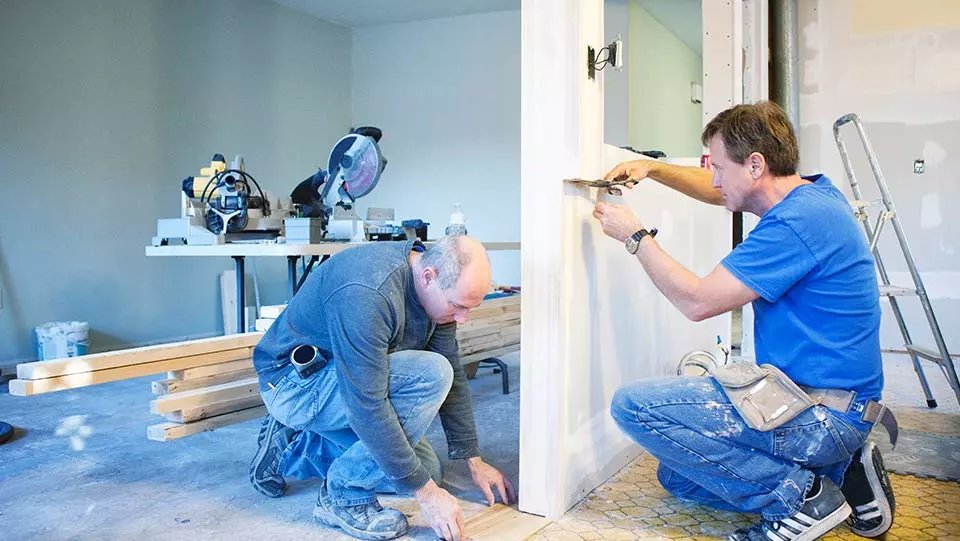How to Set Up Your Home Office


In the modern office, work can happen anywhere – on the road, in a coffee shop or at your kitchen counter. If you or anyone at your small business works from home, having a dedicated home office designed properly can help avoid painful injuries and time lost from work in the future.
The three keys to ergonomics
You can lessen the strain of working on a computer by focusing on three things:
- Proper posture
- Good work habits
- Appropriately adjusted equipment
Don’t fall into the trap of thinking that a slouched posture is more relaxing. Remember to take frequent breaks, both to stretch and to help focus. Whether you are working from home or traveling, get comfortable with adjusting your setup until it suits you.
Table/desk
You’ll want a proper desk between 28-30 inches in height, instead of working off a kitchen countertop. Avoid sitting on the floor while working and don’t use lap desks for long stretches. Other things to look for in a desk:
- Desk thickness should not exceed 2 inches.
- Allow for adequate legroom with a minimum of 18-inch depth and 24-inch knee width.
- Desks should provide depth to place the monitor at least 18-20 inches from you.
- If a desk is not available, use a dining table with a height-adjustable chair.

4 Tips for Setting Up Your Home Office Desk
- Use a proper desk that is between 28-30 inches in height.
- Desk thickness should not exceed 2 inches.
- allow for adequate leg room [min of 18-inch depth and 24-inch knee width].
- Place the monitor at least 18-20 inches from you.
Chair
Your favorite seat on the couch won’t cut it – most couches don’t support the body evenly during extended sitting. Invest in an adjustable chair with pneumatic height adjustment, lumbar back support, a height-adjustable seat back with locking function and an adjustable depth seat pan. Bonus points if it has padded armrests that are height- and depth-adjustable with rounded edges. Some other suggestions as you look for the right fit:
- Consider sitting on a small pillow so your seated elbow height is level with the keyboard and mouse.
- Use a thin pillow to provide additional support to the lower back.
- Stand, stretch or walk after sitting every two hours.
Keyboard/mouse
Instead of the built-in track pad and keyboard on your laptop, use an external keyboard and mouse. They offer greater adjustability, which is a major factor in user comfort. Make sure the mouse is next to the keyboard, and place both near the edge of the table. If the desk is too high, consider a height-adjustable keyboard tray. You can also use a small rolled-up towel to support your palms when typing.
Monitor
Take time to get the position of the monitor right. Having a monitor connected to your laptop as a second screen can offer more flexibility to have multiple documents open at once while giving you more adjustability than a laptop screen.
- Position the monitor directly in front of your body, roughly arm’s length away.
- Dual monitors should be positioned at more than an arm’s length and positioned in an arc.
- Large monitors should also be positioned at more than an arm’s reach.
- The top two-thirds of the monitor should fall within eye level.
- Use a small box, reams of paper, books, etc., to raise the height of the monitor or laptop.
- Position the monitor away from direct sunlight.
Office accessories
When your chair is raised to work at the desk height, you may need a footrest to support your feet. You may want to use a headset or speakerphone if you are on the phone for more than two hours per day. Take care with where you place documents, as looking down at the desk can place a strain on your neck. A document holder or clipboard near the monitor, at about the same height, can hold reference documents.
Lighting
Change the orientation of your desk if the sun is in your eyes, and avoid facing windows without shades or curtains. Use task lighting to highlight documents and desktop areas and lamps with diffusers or shields to help reduce glare. Remember that light from lamps should not directly face the eyes.
Taking the time to go to your home office, rather than working with a laptop propped on a coffee table or kitchen counter, might take practice, but following good ergonomic practices will make it more comfortable. You may also find that limiting work to the home office helps to create some healthy boundaries in a 24/7 “always-on” workweek.

Get comfortable with the work-from-home scenario using these tips to spruce up your home office.
1. The right chair.
Comfort is nice, but ergonomically supportive is key
2. A spot of tea or a cup of joe.
A single-cup coffeemaker or personal teapot can remind you to take that mid-morning or afternoon break.
3. A splash of color.
A piece of framed art or a bright-colored file organizer can add some energy to lift your mood. Even a healthy green plant can do the trick.
4. A touch of texture.
Use storage containers, rugs or decor that have interesting textures to help make the room feel more inviting.
5. Let there be light.
Natural light from a window can be a welcome option to facing a wall. If you don’t have a window, consider investing in a desk lamp or even the new “ring light” that can help make your video calls look more professional and well-lit.
6. Declutter.
Use bookshelves, baskets and under-desk drawers to keep items off your desk. And don’t forget the benefits of a manageable inbox.
7. Get camera-ready.
Keep the space behind you simple in design so it doesn’t distract your colleagues on video calls. One large piece of art works well.
Working from home? Learn more about Travelers’ homeowners insurance products.
VISIT travelers.com/home-insurance/coverage
travelers.com
The Travelers Indemnity Company and its property casualty affiliates. One Tower Square, Hartford, CT 06183
This material is for informational purposes only. All statements herein are subject to the provisions, exclusions and conditions of the applicable policy. For an actual description of all coverages, terms and conditions, refer to the insurance policy. Coverages are subject to the individual insureds meeting our underwriting qualifications and to state availability.
© 2021 The Travelers Indemnity Company. All rights reserved. Travelers and the Travelers Umbrella logo are registered trademarks of The Travelers Indemnity Company in the U.S. and other countries.



